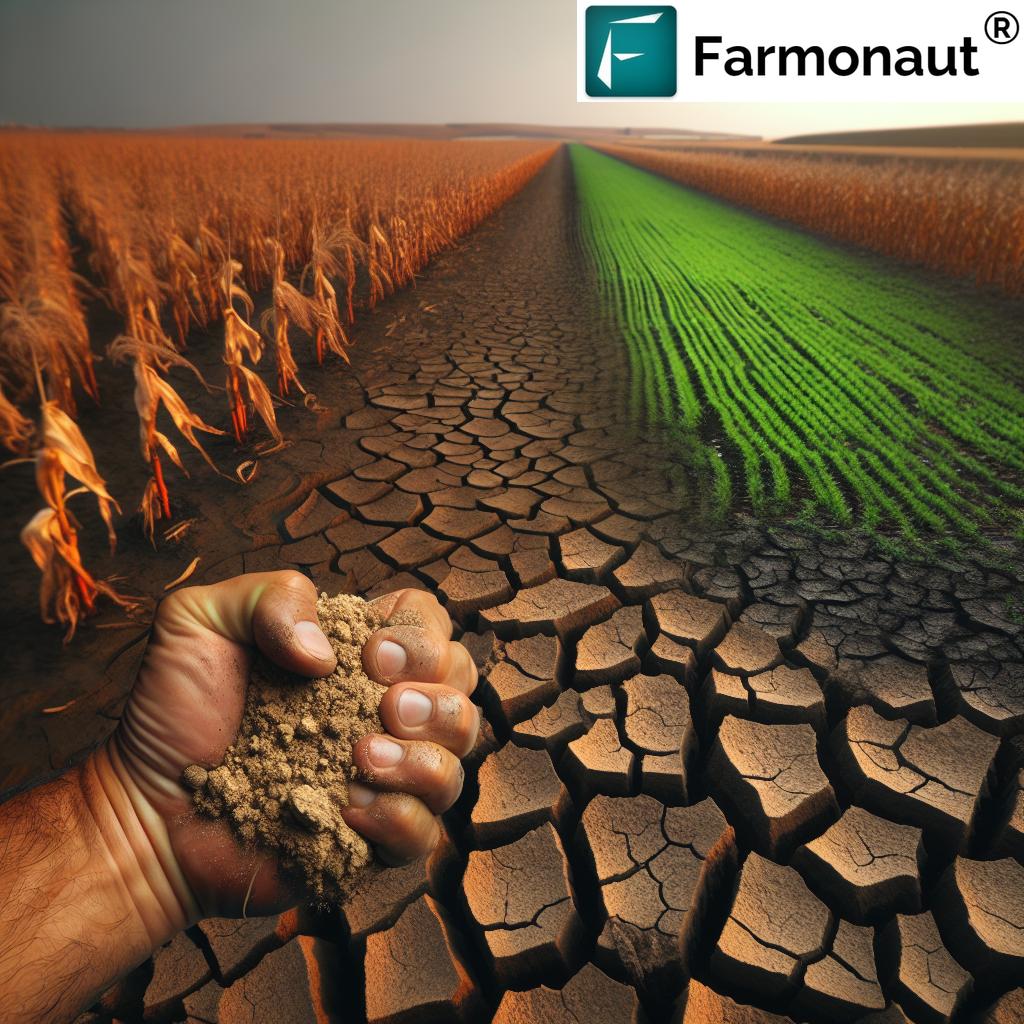Drought-Resilient Farming: Ohio’s Soil Conservation Practices for Climate Change Adaptation

“Ohio’s 2024 drought devastated agriculture, with crop yields dropping by up to 40% in severely affected areas.”
In the face of unprecedented challenges posed by climate change, Ohio’s agricultural sector finds itself at a critical juncture. The devastating drought of 2024 has brought the urgent need for drought-resilient farming and soil conservation practices into sharp focus. As we delve into this pressing issue, we’ll explore how Ohio farmers are adapting to these changing conditions and the vital role that soil health plays in ensuring the future of agriculture in the state.
The 2024 Drought: A Wake-Up Call for Ohio Agriculture
The summer of 2024 will long be remembered as one of the most challenging periods in Ohio’s agricultural history. As we witnessed firsthand, vast swathes of farmland across the state succumbed to the relentless heat and lack of rainfall. The U.S. Drought Monitor reported that an astounding 98% of Ohio was classified as “abnormally dry or worse” by late September. This unprecedented dry spell had catastrophic effects on crop yields, with the USDA’s Crop Progress & Condition Report indicating that a third of the state’s corn and soy crops were in “poor or very poor condition.”
For many Ohio farmers, the timing couldn’t have been worse. Less than a quarter of soy and corn crops were ready for harvest when the drought hit, leaving growers with the agonizing decision of whether to harvest immature crops or risk total loss. The subsequent deluge from Hurricane Helene in late September only compounded the problem, as parched fields couldn’t effectively absorb the sudden influx of water.
The Economic Impact of Drought on Ohio’s Agricultural Sector
Ohio’s agricultural sector, valued at over $16 billion in 2023, plays a crucial role in the state’s economy. The state ranks among the top 10 in the country for production of grains, greenhouse crops, and hogs. However, the 2024 drought dealt a severe blow to this vital industry:
- Corn production fell by 16% compared to 2023
- Soybean production decreased by 8%
- Many of the state’s 74,000 farms, 65% of which are less than 100 acres, faced significant financial strain
These statistics underscore the urgent need for adaptive strategies to combat the effects of climate change on agriculture. As we move forward, it’s clear that implementing drought-resilient farming practices and focusing on soil conservation will be key to ensuring the long-term viability of Ohio’s agricultural sector.
Understanding Soil Health and Its Role in Drought Resilience
At the heart of drought-resilient farming lies a crucial element often overlooked: soil health. The ability of soil to retain water and support crop growth during periods of drought is fundamentally linked to its overall health and structure. Let’s explore the science behind soil health and its importance in climate change adaptation.
The Science of Soil Aggregates
Healthy soil is composed of aggregates – crumbs of organic matter and minerals that act like sponges, retaining water and nutrients. These aggregates are formed through the complex interactions of various soil organisms:
- Insects
- Fungi
- Bacteria
- Decaying plant matter
These life forms work together to stabilize the structure of topsoil, creating a network of pores that allow for proper water infiltration and retention. However, the health and activity of these organisms are directly impacted by soil temperature and moisture levels.
Microbial Activity and Drought
Microbiologist Elizabeth Rieke from the Soil Health Institute emphasizes the critical role of soil microbes in drought resilience. During prolonged drought conditions, these beneficial microorganisms may go dormant, pausing their vital functions of water uptake and nutrient cycling. While microbes are generally resilient, extended periods of drought can lead to long-term shifts in microbial communities, potentially compromising soil health and crop productivity.
“Soil conservation practices can increase water retention capacity by 20%, crucial for drought resilience in Ohio farms.”
Soil Conservation Practices for Drought Resilience
To combat the challenges posed by drought and climate change, Ohio farmers are increasingly turning to soil conservation practices. These techniques not only improve drought resilience but also contribute to overall soil health and sustainable agriculture. Let’s explore some of the most effective practices:
1. Cover Cropping
Cover crops are plants grown primarily to protect and enrich the soil during periods when cash crops are not being cultivated. They offer multiple benefits:
- Improved soil structure and water retention
- Reduced soil erosion
- Enhanced nutrient cycling
- Increased organic matter content
For Ohio farmers looking to implement cover cropping, Farmonaut’s crop plantation advisory services can provide valuable insights on selecting the most suitable cover crops based on local soil and climate conditions.
2. No-Till Farming
No-till farming involves planting crops without disturbing the soil through tillage. This practice offers several advantages:
- Improved soil structure and water infiltration
- Reduced soil erosion and compaction
- Increased soil organic matter and carbon sequestration
- Enhanced soil biodiversity
Farmers adopting no-till practices can benefit from Farmonaut’s carbon footprinting tools to monitor and quantify the positive environmental impact of their conservation efforts.
3. Crop Rotation
Crop rotation involves growing different types of crops in the same area across seasons. This practice offers numerous benefits:
- Improved soil fertility and structure
- Reduced pest and disease pressure
- Enhanced water use efficiency
- Increased crop yields and farm profitability
To optimize crop rotation strategies, farmers can leverage Farmonaut’s AI-powered advisory system, which provides personalized recommendations based on satellite data and local conditions.
4. Contour Farming and Terracing
These practices involve planting across the slope of the land rather than up and down. Benefits include:
- Reduced soil erosion
- Improved water retention
- Enhanced nutrient retention
For large-scale implementation of these techniques, Farmonaut’s large-scale farm management tools can assist in planning and monitoring contour farming and terracing projects.
Comparative Analysis of Soil Conservation Practices in Ohio
| Conservation Practice | Water Retention Capacity (estimated %) | Soil Health Impact | Implementation Cost ($/acre) | Crop Yield Improvement (estimated %) | Climate Resilience Score (1-10) |
|---|---|---|---|---|---|
| Cover cropping | 20-30% | High | 30-50 | 10-20% | 9 |
| No-till farming | 15-25% | High | 20-40 | 5-15% | 8 |
| Contour farming | 10-20% | Medium | 40-60 | 5-10% | 7 |
| Terracing | 25-35% | Medium | 100-200 | 10-15% | 8 |
| Agroforestry | 30-40% | High | 150-300 | 15-25% | 9 |
| Crop rotation | 10-20% | High | 10-30 | 10-20% | 8 |
This table provides a comprehensive overview of various soil conservation practices, their benefits, and associated costs. It’s important to note that the effectiveness of these practices can vary depending on specific local conditions and implementation methods.
The Role of Technology in Drought-Resilient Farming
As we navigate the challenges of climate change and drought, technology plays an increasingly crucial role in supporting farmers’ efforts towards resilience. Advanced tools and platforms are empowering farmers to make data-driven decisions and implement precision agriculture techniques.
Satellite-Based Crop Monitoring
Satellite technology has revolutionized the way we monitor and manage crops. Platforms like Farmonaut utilize multispectral satellite imagery to provide real-time insights into crop health, soil moisture levels, and other critical metrics. This technology enables farmers to:
- Detect early signs of crop stress
- Optimize irrigation schedules
- Make informed decisions about fertilizer application
- Monitor the effectiveness of conservation practices
By leveraging these advanced monitoring capabilities, Ohio farmers can proactively address potential issues before they escalate, thereby improving their drought resilience and overall farm productivity.
AI-Powered Advisory Systems
Artificial Intelligence (AI) is transforming agricultural decision-making processes. AI-powered advisory systems, such as Farmonaut’s Jeevn AI, analyze vast amounts of data – including satellite imagery, weather forecasts, and historical crop performance – to generate personalized recommendations for farmers. These systems can help with:
- Optimizing planting and harvesting schedules
- Predicting pest and disease outbreaks
- Recommending the most suitable crop varieties for local conditions
- Advising on the timing and application of conservation practices
By integrating AI-driven insights into their decision-making processes, Ohio farmers can enhance their ability to adapt to changing climate conditions and improve their overall farm management strategies.
The Economic Implications of Drought and Conservation Practices
The economic impact of drought on Ohio’s agricultural sector extends far beyond immediate crop losses. It encompasses long-term effects on farm viability, rural communities, and the state’s overall economy. However, the adoption of soil conservation practices and drought-resilient farming techniques can help mitigate these economic challenges.
Short-term Costs vs. Long-term Benefits
While implementing soil conservation practices often requires initial investments, the long-term benefits can far outweigh the costs:
- Improved crop yields and quality
- Reduced input costs (e.g., fertilizers, irrigation)
- Enhanced farm resilience to weather extremes
- Potential for premium prices for sustainably produced crops
Farmers considering these practices can utilize Farmonaut’s crop loan and insurance services to help finance their transition to more sustainable farming methods.
The Role of Government Support and Incentives
Government programs play a crucial role in supporting farmers’ adoption of conservation practices. However, recent changes in federal funding have created uncertainty:
- The freeze on Inflation Reduction Act funds has impacted several USDA conservation programs
- Farmers with existing federal contracts for climate-resilient adaptations face uncertainty
- State-level support, such as Ohio’s $10 million drought relief fund, has become increasingly important
As policies evolve, it’s crucial for farmers to stay informed about available support programs and explore alternative funding sources for implementing conservation practices.
Looking Ahead: The Future of Drought-Resilient Farming in Ohio
As we confront the realities of climate change, the future of agriculture in Ohio depends on our ability to adapt and innovate. The path forward involves a combination of traditional wisdom, cutting-edge technology, and a commitment to sustainable practices.
Embracing Innovation
The agricultural sector must continue to embrace technological innovations to enhance drought resilience:
- Advanced weather forecasting and climate modeling
- Precision agriculture techniques for optimal resource use
- Development of drought-tolerant crop varieties
- Integration of IoT devices for real-time farm monitoring
Platforms like Farmonaut are at the forefront of this innovation, providing farmers with the tools they need to navigate an increasingly unpredictable climate.
Building Community Resilience
Drought resilience extends beyond individual farms to entire communities. Future efforts should focus on:
- Knowledge sharing among farmers
- Collaborative water management strategies
- Development of local food systems to reduce vulnerability to global supply chain disruptions
- Investment in rural infrastructure to support sustainable agriculture
By working together and leveraging available technologies, Ohio’s agricultural communities can build a more resilient and sustainable future.
Conclusion: A Call to Action for Drought-Resilient Farming
The challenges posed by drought and climate change to Ohio’s agricultural sector are significant, but not insurmountable. By embracing soil conservation practices, leveraging advanced technologies, and fostering a culture of innovation and collaboration, we can build a more resilient and sustainable agricultural future for the state.
As we move forward, it’s crucial that all stakeholders – farmers, policymakers, researchers, and technology providers – work together to develop and implement effective strategies for drought-resilient farming. The future of Ohio’s agriculture, and indeed the state’s economy and food security, depends on our collective efforts to adapt to changing climate conditions.
By taking action now and investing in sustainable practices, we can ensure that Ohio’s farms not only survive but thrive in the face of future climate challenges. The path to drought resilience may be challenging, but it’s one we must embark on together for the sake of our farms, our communities, and our future.
FAQ Section
Q1: What are the most effective soil conservation practices for improving drought resilience?
A1: The most effective practices include cover cropping, no-till farming, crop rotation, and contour farming. These techniques improve soil structure, increase water retention capacity, and enhance overall soil health.
Q2: How can technology help farmers adapt to drought conditions?
A2: Technologies like satellite-based crop monitoring, AI-powered advisory systems, and precision agriculture tools can help farmers make data-driven decisions, optimize resource use, and implement targeted conservation practices.
Q3: What are the economic benefits of implementing drought-resilient farming practices?
A3: While there may be initial costs, long-term benefits include improved crop yields, reduced input costs, enhanced farm resilience to weather extremes, and potential access to premium markets for sustainably produced crops.
Q4: How can farmers finance the transition to more sustainable farming methods?
A4: Farmers can explore government support programs, state-level incentives, and specialized financial services like Farmonaut’s crop loan and insurance offerings to help finance their transition to sustainable farming practices.
Q5: What role does soil health play in drought resilience?
A5: Healthy soil with good structure and high organic matter content has a greater capacity to retain water, support beneficial microbial communities, and maintain crop productivity during drought conditions.
Earn With Farmonaut: Affiliate Program
Earn 20% recurring commission with Farmonaut’s affiliate program by sharing your promo code and helping farmers save 10%. Onboard 10 Elite farmers monthly to earn a minimum of $148,000 annually—start now and grow your income!

















